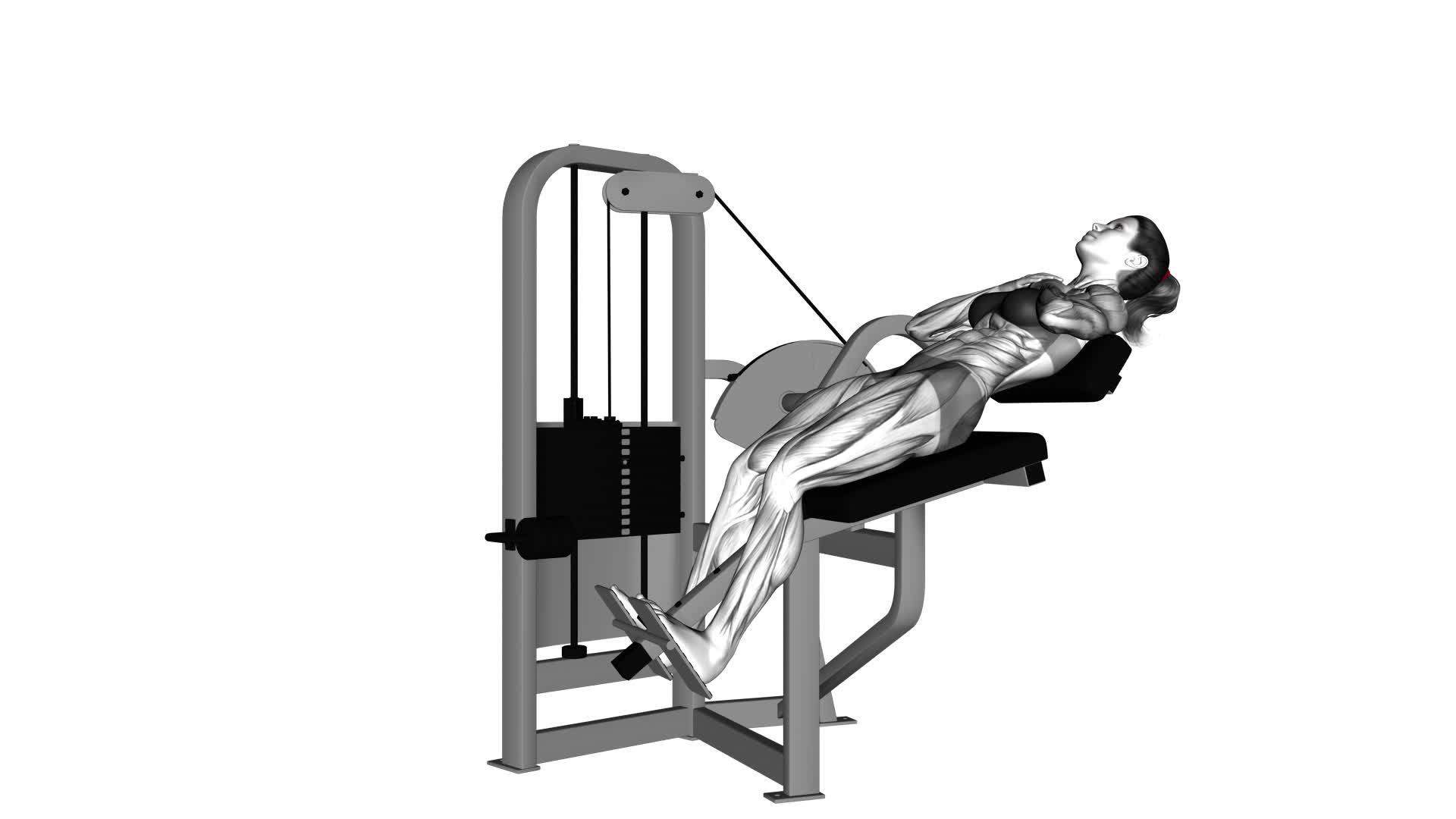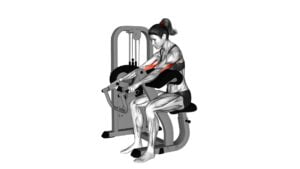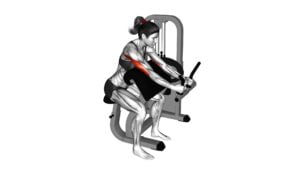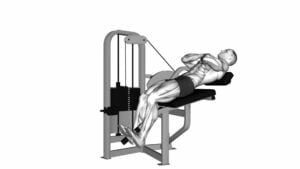Lever Back Extension (version 2) (female) – Video Exercise Guide & Tips

Are you looking to strengthen and tone your back muscles?
Watch This Exercise Video
In this video exercise guide, we'll walk you through Lever Back Extension (version 2), specifically designed for females. With proper form and technique, you can reap the benefits of this exercise, including improved posture and increased back strength.
We'll also share common mistakes to avoid, variation options, and tips for maximizing effectiveness.
Get ready to take your back workout to the next level with Lever Back Extension (version 2)!
Key Takeaways
- Lever Back Extension (version 2) targets the erector spinae muscles in the lower back for females.
- This exercise improves posture, reduces the risk of lower back pain, and strengthens the glutes and hamstrings.
- It enhances lower body strength, stability, core stability, and balance.
- To maximize effectiveness, maintain proper form, engage the core, and progress at your own pace.
Benefits of Lever Back Extension (version 2) for Females
There are three key benefits of performing Lever Back Extension (version 2) for females.
First, this exercise targets the muscles in your lower back, specifically the erector spinae muscles. By strengthening these muscles, you can improve your posture and reduce the risk of lower back pain.
Second, Lever Back Extension (version 2) also engages your glutes and hamstrings, helping to tone and strengthen these muscles. This can enhance your overall lower body strength and stability.
Lastly, this exercise can improve your core stability and balance. The movement of extending your back while maintaining a stable position activates your core muscles, including your abdominals and obliques. This can lead to better control and coordination in your daily activities and other physical exercises.
To reap these benefits, it's important to perform Lever Back Extension (version 2) with proper form and technique. This involves lying face down on a mat, placing your hands by your sides, and lifting your upper body off the ground using your back muscles. Remember to keep your neck in a neutral position and avoid any jerky movements.
Proper Form and Technique for Lever Back Extension (version 2)
To perform Lever Back Extension (version 2) with proper form and technique, you should start by lying face down on a mat and placing your hands by your sides. Keep your legs straight and together, and point your toes towards the ground. Engage your core and glutes to lift your upper body off the mat, while keeping your neck in a neutral position. As you lift, focus on squeezing your shoulder blades together and feeling the contraction in your upper back muscles.
Maintain a controlled movement throughout the exercise, avoiding any jerking or swinging motions. This will help to ensure that you're targeting the intended muscles and reducing the risk of injury.
Common mistakes to avoid include lifting your legs off the mat, arching your lower back excessively, and using momentum to lift your upper body. These errors can lead to improper muscle activation and strain on the lower back.
To add variety to your routine, you can try different arm positions, such as placing your hands behind your head or extending them straight out in front of you.
To progress in this exercise, you can increase the number of repetitions, add resistance by holding a weight plate against your chest, or perform the exercise on an unstable surface, such as a stability ball.
Remember to always listen to your body and modify or progress the exercise as needed. Incorporating Lever Back Extension (version 2) into your workout routine can help to strengthen your upper back, improve posture, and enhance overall back stability.
Common Mistakes to Avoid During Lever Back Extension (version 2)
Avoid these common mistakes when performing Lever Back Extension (version 2) to ensure proper form and maximize the effectiveness of the exercise. By paying attention to these tips for improvement, you can make the most out of your workout and reduce the risk of injury.
One common mistake to avoid is using momentum to lift your legs instead of relying on your back muscles. It's important to engage your back muscles and control the movement throughout the exercise.
Another mistake is arching your lower back excessively. This can put unnecessary strain on your spine. Instead, maintain a neutral spine position throughout the exercise.
Another mistake to watch out for is lifting your legs too high. This can cause your lower back to hyperextend and lead to discomfort or injury. Instead, focus on lifting your legs to a comfortable height while maintaining proper form.
Furthermore, avoid holding your breath during the exercise. Remember to breathe steadily and deeply throughout each repetition. This will help you maintain proper form and prevent unnecessary tension in your muscles.
Incorporating these tips into your Lever Back Extension (version 2) routine will help you achieve better results and reduce the risk of injury. Remember to listen to your body and make adjustments as needed to ensure a safe and effective workout.
Variation and Progression Options for Lever Back Extension (version 2)
To vary and progress your Lever Back Extension (version 2), try incorporating different resistance levels or adding additional challenges to the exercise. By changing the resistance level, you can increase or decrease the difficulty of the exercise. If you find the exercise too easy, try using a heavier resistance band or adding weights to your ankles. This will engage your muscles more and provide a greater challenge. On the other hand, if the exercise is too challenging, you can use a lighter resistance band or remove the weights from your ankles. This will allow you to focus on proper form and build strength gradually.
Another way to vary and progress the Lever Back Extension (version 2) is by adding additional challenges. You can try performing the exercise on an unstable surface, such as a stability ball or a foam pad. This will require more core stability and engage additional muscles. Additionally, you can perform the exercise with a pause at the top of the movement or with a slower tempo. This will increase time under tension and further challenge your muscles.
Remember to listen to your body and progress at your own pace. It's important to challenge yourself, but also to maintain proper form and avoid injury. By incorporating different resistance levels and adding additional challenges, you can continue to make progress and improve your strength and stability with the Lever Back Extension (version 2).
Tips for Maximizing the Effectiveness of Lever Back Extension (version 2)
To maximize the effectiveness of the Lever Back Extension (version 2), focus on maintaining proper form and engaging your muscles throughout the entire range of motion. By following these tips, you can maximize your results and prevent injuries:
- Keep your core engaged: Tighten your abdominal muscles throughout the exercise to stabilize your spine and protect your lower back.
- Control the movement: Avoid using momentum to swing your body up and down. Instead, focus on a slow and controlled motion to fully engage your back muscles.
- Squeeze your glutes: At the top of the movement, consciously squeeze your glutes to activate your posterior chain and enhance the effectiveness of the exercise.
- Mind your breathing: Inhale as you lower your body and exhale as you raise it. This coordinated breathing can help you maintain control and engage your muscles more effectively.
- Gradually increase resistance: As you get stronger, gradually increase the resistance by using heavier weights or resistance bands. This will challenge your muscles and promote further progress.
By implementing these tips, you can maximize the effectiveness of the Lever Back Extension (version 2) exercise, achieve better results, and reduce the risk of injuries.
Remember to always listen to your body, start with lighter weights, and consult a fitness professional if you have any concerns or questions.
Sample Workout Routine Incorporating Lever Back Extension (version 2)
To incorporate Lever Back Extension (version 2) into your workout routine, start by performing 3 sets of 10 repetitions, gradually increasing the resistance as you get stronger. This exercise is a great way to strengthen your lower back and improve your overall posture. However, it's important to modify the workout to suit your fitness level and any specific needs or limitations you may have.
If you find the Lever Back Extension (version 2) too challenging at first, you can start by using lighter resistance or even just your body weight. As you become more comfortable with the movement, you can gradually increase the resistance by adding weights or using resistance bands.
Additionally, if you're looking for alternative exercises to complement the Lever Back Extension (version 2), there are a few options you can consider. One alternative is the Superman exercise, which involves lying face down on the floor and lifting your arms and legs off the ground simultaneously. Another option is the Bird Dog exercise, which involves getting on all fours and extending opposite arm and leg. Both of these exercises target the muscles in your lower back and can be incorporated into your workout routine alongside the Lever Back Extension (version 2).
Remember to always listen to your body and consult with a fitness professional if you have any concerns or questions about modifying your workout routine.
Frequently Asked Questions
Can Lever Back Extension (Version 2) Help With Lower Back Pain in Females?
Lever back extension (version 2) can be helpful for reducing lower back pain in females. By strengthening the muscles in your back, it can provide support and stability to the spine. However, it's important to note that there are alternative exercises available that can also target the lower back.
Additionally, proper form is crucial in lever back extension (version 2) exercises to avoid injury and maximize the benefits.
How Often Should Females Perform Lever Back Extension (Version 2) Exercises?
To get the most out of lever back extension (version 2) exercises, it's important for females to know how often to do them. The frequency of these exercises depends on your fitness level and goals.
Generally, it's recommended to perform lever back extension (version 2) exercises 2-3 times per week. This frequency allows your muscles to recover while still reaping the benefits of increased lower back strength and flexibility.
Remember to listen to your body and adjust the frequency as needed.
Are There Any Specific Modifications or Adaptations for Females With Different Fitness Levels?
When it comes to fitness modifications and gender-specific adaptations, there are certain considerations for females with different fitness levels.
It's important to tailor the lever back extension exercise to your specific needs and abilities. Depending on your fitness level, you may need to adjust the weight, range of motion, or the number of repetitions.
It's always a good idea to consult with a fitness professional who can provide guidance and help you make the necessary modifications.
Can Lever Back Extension (Version 2) Exercises Help Improve Posture in Females?
Lever back extension (version 2) exercises can be beneficial in improving posture for females. By incorporating these exercises into your routine, you can work on strengthening your core and improving flexibility, which are key factors in maintaining good posture.
These exercises target the muscles in your back, helping to strengthen them and promote proper alignment. Incorporating lever back extension (version 2) exercises into your fitness routine can lead to better posture and overall body alignment.
Are There Any Contraindications or Precautions for Females When Performing Lever Back Extension (Version 2) Exercises?
When performing lever back extension (version 2) exercises, it's important for females to be aware of any contraindications or precautions.
It's crucial to consult with a healthcare professional before starting this exercise to ensure it's safe for you. Some contraindications may include pre-existing back conditions or injuries.
Precautions may include starting with lighter weights and gradually increasing intensity to avoid strain.
Remember to listen to your body and stop if you experience any pain or discomfort.
Conclusion
In conclusion, the Lever Back Extension (version 2) is a beneficial exercise for females looking to strengthen their back muscles.
By following proper form and technique, avoiding common mistakes, and incorporating variation and progression options, women can maximize the effectiveness of this exercise.
By including Lever Back Extension (version 2) in a regular workout routine, females can achieve a stronger and more toned back.

Author
Years ago, the spark of my life’s passion ignited in my mind the moment I stepped into the local gym for the first time. The inaugural bead of perspiration, the initial endeavor, the very first surge of endorphins, and a sense of pride that washed over me post-workout marked the beginning of my deep-seated interest in strength sports, fitness, and sports nutrition. This very curiosity blossomed rapidly into a profound fascination, propelling me to earn a Master’s degree in Physical Education from the Academy of Physical Education in Krakow, followed by a Sports Manager diploma from the Jagiellonian University. My journey of growth led me to gain more specialized qualifications, such as being a certified personal trainer with a focus on sports dietetics, a lifeguard, and an instructor for wellness and corrective gymnastics. Theoretical knowledge paired seamlessly with practical experience, reinforcing my belief that the transformation of individuals under my guidance was also a reflection of my personal growth. This belief holds true even today. Each day, I strive to push the boundaries and explore new realms. These realms gently elevate me to greater heights. The unique combination of passion for my field and the continuous quest for growth fuels my drive to break new ground.



